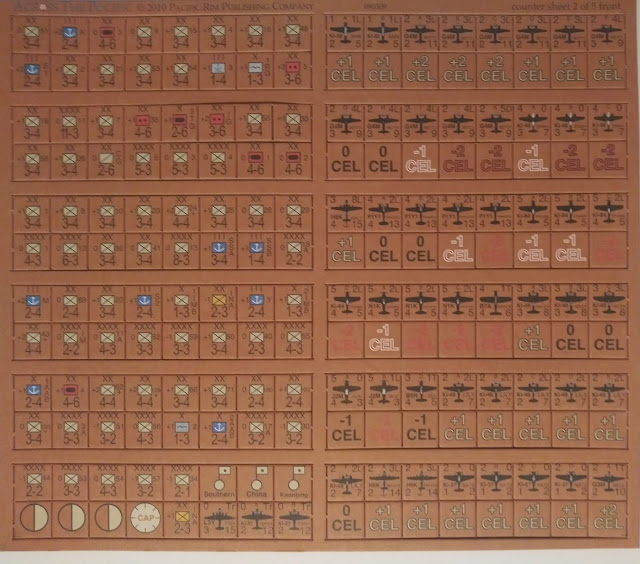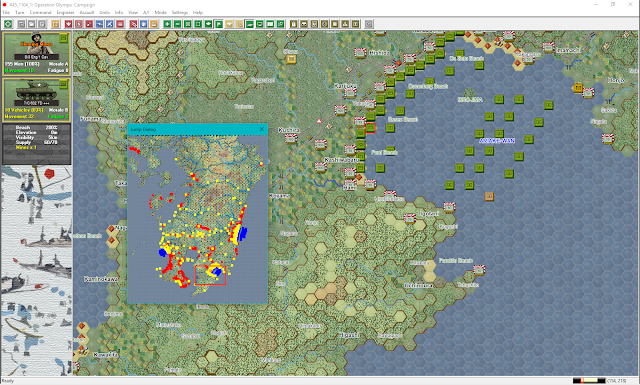On the cover is the dramatic moment when MacArthur lands back on the island of Leyte in the Philippines. A lot of people do not know that he was a Field Marshal in the Philippine Army. He had actually retired from the US Army in 1937. His own history is full of defenders and detractors. When the Japanese invaded the Philippines in 1941, he had been in charge of the defense of the Islands. One day after the attack on Pearl Harbor and war was declared, his air units were still nicely lined up on the airfields for the Japanese to destroy a good number of them (the Japanese could not fly on December 7th because of the weather). The rest of the '41 campaign saw the Japanese break through the Philippino/American forces time and again. The forces under MacArthur were nowhere near ready for war as the Japanese forces were. Unfortunately, the Philippines was lost to the Japanese in a matter of Months. This game is about the American invasion of the Philippines in 1944.

This is what Wargame Design Studio has to say about the game:
"On October 20, 1944, General Douglas MacArthur delivered his famous “I Have Returned” speech upon landing on Leyte Island. It is one of the most iconic phrases of the war, coupled with some of the most famous photographs, that captured the moment as he waded ashore.
With the return to the Philippines in 1944, both Roosevelt and McArthur’s pledges were honored, but this was to be a titanic struggle to liberate the islands for the next eight months.
In Philippines ’44, as MacArthur you will command units from both the US Sixth and Eighth Armies as well as US Army Air Force and Naval air groups. The Japanese forces, led by General Yamashita, had at his disposal, three major commands, the Shobu, Shimbu and Kembu Groups. Yamashita’s command outnumbered the Allied forces but had to defend a vast territory with limited knowledge of where the Allied forces may land. All that is lacking is for you to kick off one of the largest land campaigns of the Pacific War."
The campaigns you will be able to fight are:
The liberation of Leyte: Oct 20, 1944 - Dec 23, 1944
The liberation of Luzon: Jan 9, 1945 - Jun 22, 1945
The liberation of Manila: Mar 3, 1945
The Northern Luzon Campaign: Mar 6, 1945 - Apr 26, 1945
Once again, Wargame Design Studio has sent me a game to review that is too large to really do so, unless I devoted my entire gaming life to playing this game for about six months or more. There are too many scenarios, and they are so large that the campaign games cannot really be played until their outcome is decided. Luckily the game does come with some smaller scenarios that can be played in full. I am talking about the time a review would be expected of the game. Once you buy one of their games, feel free to forget about your life and dive in.

While this is a brand-new game from Wargame Design Studio most of their games came from the John Tiller stable of wargames. These were originally released by HPS about 20 or so years ago. However, all of Wargame Design Studio's games have been updated thoroughly within the last few years. The games might have a resemblance as to their looks, but their DNA has definitely been changed. Even the resemblance is starting to go away with how many changes that WDS has built into the games. Some people have complained that Philippines '44 should not be listed under the title of Panzer Campaigns. It has been placed there because the only WWII campaigns that were released had Panzers. If you look on their web site and see Japan or the Philippines, it should not cause your brain to misfire.

As I mentioned before, these games are huge. The real work with these games is behind the surface. Look above at the listing of the troops and units that were included. These games go down to each single man, machine gun, and other weapons. I cannot even believe the amount of work that would need to be done to get this correct. Yes, we do have computers now but still the amount of cross checking boggles my mind. Look at the numbers in this breakdown below:
"Philippines '44 includes 76 Scenarios – covering all sizes and situations, including a solo tutorial scenario plus specialized versions for both head to head play and vs. the computer AI.
The master maps for Leyte (24,570 hexes) and Luzon (184,800 hexes) cover the main landing beaches and subsequent advances to liberate cities such as Manila.
The order of battle file covers the Axis and Allied forces that participated in the campaign with other formations added in for hypothetical situations.
Order-of-Battle, Parameter Data and Scenario Editors which allow players to customize the game.
Sub-map feature allows the main map to be subdivided into smaller segments for custom scenario creation.
Design notes which cover or include the production of the game, campaign notes and a bibliography that includes the sources used by the Wargame Design Studio team to produce this simulation game.
Philippines '44 provides multiple play options including play against the computer AI, Play by E-mail (PBEM), LAN & Internet "live" play as well as two player hot seat."
184,800 hexes! Try and roll that neatly off the tongue.
Now we have to dispel at least one myth. "My grandfather told me that the AI in these games is terrible". Yes, when using Microsoft 3.1 that AI was not that good. However, it never stank. People would play one game until they found a weakness in the AI and then use it and post about it continuously. If you have enough time in your life to spend doing that, then my hat is off to you. I would be able to play maybe once per week for a few hours. The amount of time that came between those hours of play were enough for me to forget about what I was doing, and possibly what my name was. As you can see from above, nowadays there are certain scenarios that have been set up from the very beginning to be played against the AI. Believe it or not, about 80-90% of the PC game players play against AIs. This number includes all of the multi-player games that abound now.

So, where does all this leave us? What we have is a game that if judged by board wargames would possibly be the size of a 4' X 4' skid or pallet. Just think about it. If you could ever find a place to put the maps, maybe a gymnasium floor, the next hurdle would be to start slicing and dicing the 30 lbs. of 1/2" counters. Unless you had hired out a good number of workers, there is no way you are not getting carpal tunnel syndrome in both hands. The sheer vastness of what goes into these games should make your head spin. A very large board wargame with this much depth would cost into the hundreds of dollars (ask my wife she knows). These can be bought for $39.95! I could paint that car for $39.95 (you have to be a certain age to get the joke).

To try and explain how one of these games are played would be a pretty big task. That is why much smaller and easier scenarios are included in the games now. You would need to learn about Logistics and combined arms to name just two things that come to mind. If you tried to print off an AAR of one of the big scenarios, you'd better hope you have enough ink. One of the best things about these games is that they are meant to be played in a historical manner. These are not Panzer General clones. I am not saying that you are forced to only play the game out historically. You have to play it like a general from the 1940s. Japanese tanks out in the open against Shermans is just a foolish move. Now, if you dig in those tanks and put some other antitank forces with them, then you are talking.
The odd thing about the 1941 and 1944-45 campaigns is that both sides had changed places. In 1941 you had a smaller but better equipped Japanese force invade the Philippines. In 1944 the American invasion force was smaller but better equipped than the defending Japanese.
Grognards who have played these games for many years will only have to get used to the new upgrades to this group of games. The smaller scenarios are where a tyro to these games should begin. These are very deep games that give you the control of units that a board wargamer is more used to than a computer wargamer. You have to control not only your tanks and infantry but also your air units and artillery.
This game is going to be different than slicing Panzers or Shermans and T-34s across Europe. The terrain can be both a hindrance and a help depending upon your victory conditions in your chosen scenario. I almost always play the underdog in any wargame. In these scenarios it is the Japanese. The maps in most of the scenarios are large enough for you to give up land to keep your units intact and slow the American advance to a crawl. Unlike Yamashita, who historically had to deal with the Japanese Banzai attitude, the game allows you to give orders to your troops that will be obeyed. The American artillery is your greatest fear. You will always read in books that the Russians' God of War was their Artillery. The Russians would release the power of thousands of guns. Strangely, if you read the stories of Germans who fought on both the Russian and Western Front you will read a different tale. They say that nothing on the Russian Front had prepared them for the onslaught of the English and American artillery, especially the American. You will also have to deal with the American Air Forces. They have almost complete control of the skies around the Philippines. On the invasion beaches you will also have to deal with the guns of the American Naval Forces. One destroyer with four or five 5" guns can ruin your day, let alone the massive fire from a capital ship.
Thank you, Wargame Design Studio, for letting me review this great addition to your already huge stable of games. In the time that it has taken me to review this game I see you have released at least two more updates to the other games. Now then, let us get you back to work on some of the more unknown battles and campaigns in history.
Robert
Wargame Design Studio:
Philippines '44:























































Follow Us